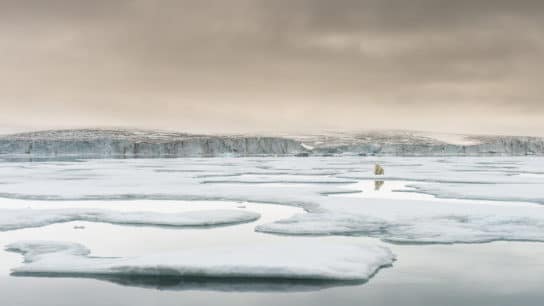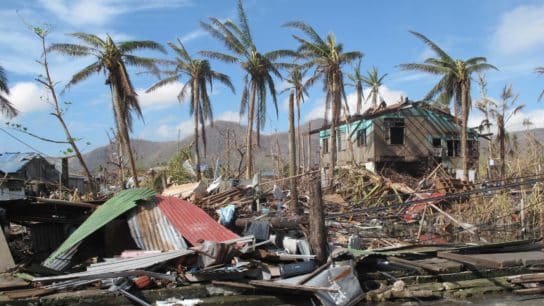Climate change and global warming are leading to glaciers melting, rising sea levels worldwide and posing threats to people around the globe, especially populations residing in coastal areas. In the face of rising sea levels, what measures should be taken to address this challenge effectively?
—
Sea level rise, as its name suggests, refers to an increase in the total volume of ocean water. This phenomenon occurs due to the melting of glaciers and polar ice sheets as well as the natural expansion of water as it warms – both outcome of climate change, which is primarily driven by the combustion of fossil fuels.
According to a 2018 report published by the WCRP Global Sea Level Budget Group, 42% of sea level rise stems from the expansion of warming ocean water with rising temperatures driven and 21% from the melting glaciers worldwide, while 23% is attributed to the melting of ice sheets in Greenland and Antarctica.
Over the past 20 years, the increase in sea levels has exacerbated coastal flooding, resulting in 14 million more individuals worldwide residing in coastal communities facing a 1-in-20 annual flood risk, 2023 data shows. If global greenhouse gas emissions continue at the current pace, it is estimated that by the end of the century, the number of people affected by coastal flooding will rise to 73 million.
A striking example of this is Panama. A recent study conducted by the Climate Change directorate of Panama’s Environmental Ministry, in collaboration with universities in Panama and Spain, projects that by 2050, Panama is expected to lose approximately 2.01% of its coastal territory due to rising sea levels. Some of its islands are already disappearing.
In the tiny island of Gardi Sugdub, one of around 50 populated islands in the archipelago of the Guna Yala territory, some 300 families are preparing to leave.

“We’re a little sad, because we’re going to leave behind the homes we’ve known all our lives, the relationship with the sea, where we fish, where we bathe and where the tourists come, but the sea is sinking the island little by little,” Nadín Morales, 24, who prepared to move with her mother, uncle and boyfriend, told AP in June.
So, How Do We Stop Sea Level Rise?
Responses to climate change are generally categorised into two main approaches: mitigation and adaptation.
Climate mitigation aims to stabilise the climate system by decreasing greenhouse gas emissions and enhancing emissions sequestration through methods like forest conservation or carbon capture technologies. On the other hand, adaptation seeks to minimise the negative effects of climate change by implementing strategies including disaster risk reduction and enhancing the resilience of food production and freshwater resources.
One of the primary causes of sea level rise is thermal expansion promoted by higher ocean temperature. The Earth is warming predominantly because of the accumulation of heat-trapping greenhouse gases emitted from burning fossil fuels, with 90% of them being absorbed by the oceans. This absorption leads to an increase in ocean temperatures and subsequent expansion in volume. Therefore, mitigation measures that aim at reducing emissions, including policies concerning the development of clean energy, green transportation as well as sustainable food, agriculture, and land use, are all vital for tackling sea level rise.
For example, policies advocating fuel efficiency and sustainable modes of transport like walking and cycling hold significant importance in reducing emissions. In addition, land-use policies that focus on conserving existing forests, one of the world’s biggest carbon sinks, and fostering the growth of new ones are also important for decreasing greenhouse gas in the atmosphere. Forests absorb nearly 16 billion metric tonnes of carbon dioxide per year globally and currently hold 861 gigatonnes of carbon in their branches, leaves, roots, and soils, This carbon storage helps reduce the concentration of carbon dioxide in the atmosphere, thereby mitigating the acceleration of ocean temperature increase, glacier melting, and thus resultant sea level rise.
Adaptation measures such as building infrastructure to protect communities at risk and planting mangroves or other vegetation to absorb water are effective measures to enhance resilience to water-related challenges. Some concrete examples include:
Coastal infrastructure construction
Sea walls can be constructed in a parallel alignment to coastlines to reduce flooding, prevent erosion, and shield against storm surges. However, the construction of such barriers is a complex endeavour that requires perpetual maintenance. Another shortcoming is that the force of water against a new wall can intensify flooding in areas beyond the wall’s protection.
Venice, one of the cities most at threat from rising sea levels in the world, constructed 78 gates in the sea to block the tide when needed and minimise risk of flooding. The MOSE (Modulo Sperimentale Elettromeccanico) project is a complex system of movable barriers that can be raised during exceptional tide events to prevent flooding in the Venetian Lagoon. Aside from numerous challenges, including delays, corruption scandals, and cost overruns, the project faced scrutiny over the impact it could have on the lagoon’s delicate ecosystem. Questions about the long-term effectiveness of the barriers also persist.
One significant issue is the uncertainty surrounding how well the barriers will adapt to future sea level rise projections. As climate change accelerates, the anticipated sea level increases may outpace the design capacity of the barriers, potentially rendering them inadequate in the long term. Additionally, there are fears about the structural integrity of the barriers over time, considering the harsh marine environment in which they operate. Corrosion, sedimentation, and mechanical wear are among the factors that could impact the functionality of the barriers, raising doubts about their ability to withstand the test of time.

The evolving nature of climate change and the increasing frequency of extreme weather events introduce complexities in predicting the effectiveness of the MOSE system in the face of unprecedented challenges, highlighting the need for continuous monitoring, adaptation, and innovation to ensure the long-term resilience of Venice against rising sea levels. This, of course, applies to similar adaptation projects elsewhere and are some of the most pressing challenges the world faces today in terms of adaptation.
Coastal wetlands protection
Wetlands act as natural sponges, absorbing and temporarily storing floodwaters. Having the capacity to impede and regulate the flow of floodwaters into rivers and streams, wetlands play a crucial role in mitigating the intensity of downstream flooding and erosion. By effectively lowering flood levels, wetlands provide a vital shield, safeguarding individuals, assets, infrastructure, and agricultural lands from the destructive impacts of flooding. This protective function not only ensures the resilience of vulnerable coastal communities but also yields substantial economic benefits, amounting to an estimated $23 billion in annual savings.
Communities relocation
When facing the threat of sea level rise, relocating from hazardous zones is a viable response strategy. For example, Fiji’s government plans to relocate entire villages due to the threat of rising sea levels.
In 2014, around 140 Fijian residents from Vunidogoloa, a village on the island of Vanua Levu, the country’s second-biggest island, took the challenging step of leaving their homes, marking the beginning of a larger scale inland relocation process. Currently, the government has identified more than 40 villages earmarked for relocation over the next five to ten years.
Relocation is often an option of last resort for communities due to its expensive financial, psychological, and social costs. According to a 2024 research paper published in Nature, relocation can lead to economic strains such as increased debt and limited job prospects and can have social impacts like weakened community connections and a loss of cultural identity. It also reveals that communities exposed to sea level rise, relocation, and government-led adaptation programs might experience lower levels of health and well-being compared to those unaffected by such interventions.
Final Thoughts
As global temperatures continue to increase, additional sea level rise is inevitable. How much and by when depends mostly on the future rate of greenhouse gas emissions. In 2023, global average sea level set a new record high: 101.4 mm above 1993 levels. According to the Intergovernmental Panel on Climate Change’s (IPCC) Sixth Assessment Report published in 2023, if the world transitions towards a sustainable path, adheres to development objectives, and achieves the Paris climate target of limiting global warming to 1.5C by 2050, the projected global mean sea level rise in the short term, over the next century, is estimated to be between 0.28-0.55 metres.
In order to avoid climate catastrophe and prepare for the effects we are already starting to experience, it is crucial for significant polluting countries and corporations to fulfil their climate pledges. This involves decreasing deforestation and fossil fuel emissions, promoting climate-friendly solutions like clean energy, and fortifying resources such as green banks. Additionally, implementing adaptation measures, such as constructing coastal infrastructure and assisting vulnerable populations in relocating to higher ground, is key to manage the challenges posed by sea level rise.
How can I contribute to a more sustainable planet?
- 🗳️ Vote for Climate Action: Exercise your democratic rights by supporting candidates and policies that prioritize climate change mitigation and environmental protection. Stay informed with Earth.Org’s election coverage.
- 👣 Reduce Your Carbon Footprint: Make conscious choices to reduce your carbon footprint. Opt for renewable energy sources, conserve energy at home, use public transportation or carpool, and embrace sustainable practices like recycling and composting.
- 💰 Support Environmental Organizations: Join forces with organizations like Earth.Org and its NGO partners, dedicated to educating the public on environmental issues and solutions, supporting conservation efforts, holding those responsible accountable, and advocating for effective environmental solutions. Your support can amplify their efforts and drive positive change.
- 🌱 Embrace Sustainable Habits: Make sustainable choices in your everyday life. Reduce single-use plastics, choose eco-friendly products, prioritize a plant-based diet and reduce meat consumption, and opt for sustainable fashion and transportation. Small changes can have a big impact.
- 💬 Be Vocal, Engage and Educate Others: Spread awareness about the climate crisis and the importance of environmental stewardship. Engage in conversations, share information, and inspire others to take action. Together, we can create a global movement for a sustainable future.
- 🪧 Stand with Climate Activists: Show your support for activists on the frontlines of climate action. Attend peaceful protests, rallies, and marches, or join online campaigns to raise awareness and demand policy changes. By amplifying their voices, you contribute to building a stronger movement for climate justice and a sustainable future.
For more actionable steps, visit our ‘What Can I do?‘ page.
This story is funded by readers like you
Our non-profit newsroom provides climate coverage free of charge and advertising. Your one-off or monthly donations play a crucial role in supporting our operations, expanding our reach, and maintaining our editorial independence.
About EO | Mission Statement | Impact & Reach | Write for us














